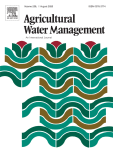Ver ítem
- xmlui.general.dspace_homeCentros Regionales y EEAsCentro Regional Mendoza - San JuanEEA La ConsultaArtículos científicosxmlui.ArtifactBrowser.ItemViewer.trail
- Inicio
- Centros Regionales y EEAs
- Centro Regional Mendoza - San Juan
- EEA La Consulta
- Artículos científicos
- Ver ítem
Vegetative growth, yield, and crop water productivity response to different irrigation regimes in high density walnut orchards (Juglans regia L.) in a semi-arid environment in Argentina
Resumen
The area dedicated to walnut orchards has recently expanded in central-western Argentina. Nevertheless, studies on crop water demand are scarce and fundamental in semi-arid environments. This work aims to evaluate the effects on stem water potential (SWP) and stomatal conductance (gs), vegetative growth (trunk cross-sectional area, canopy volume, and canopy porosity), and water productivity in terms of yield of four water irrigation regimes T50, T75,
[ver mas...]
The area dedicated to walnut orchards has recently expanded in central-western Argentina. Nevertheless, studies on crop water demand are scarce and fundamental in semi-arid environments. This work aims to evaluate the effects on stem water potential (SWP) and stomatal conductance (gs), vegetative growth (trunk cross-sectional area, canopy volume, and canopy porosity), and water productivity in terms of yield of four water irrigation regimes T50, T75, T100, and T125. The plants were irrigated at 50%, 75%, 100%, and 125%, of crop evapotranspiration, respectively over two consecutive seasons (2018–2019 and 2019–2020). The experiment was carried out in a young walnut orchard cv. Chandler in a semiarid environment in La Rioja province, Argentina. SWP and gs had similar seasonal behavior in both seasons. T100 SWP remained between 0.5 and 0.8 MPa, like T75, while T50 reached minimum values of − 1.0 MPa. Stomatal conductance was less responsive than SWP to water deficit, showing significant differences only at 100 days after bloom. Vegetative growth and yield components did not differ among treatments. Compared to T100 and T50, crop water productivity (CWP) increased from 4.30 to 5.29 dry yield mm−1 ha−1 in 2018–2019 and from 5.25 to 7.28 kg dry yield mm−1 ha−1 in 2019–2020; while T75 CWP did not differ from the CWP of T100. Irrigation doses greater than crop requirements (T125) have no effect on yield if compared with T100, and in terms of the water productivity function, irrigation at 90% of T100 would have allowed for maximum productivity in both seasons.
[Cerrar]

Autor
Calvo, Franco Emmanuel;
Trentacoste, Eduardo Rafael;
Silvente, Sonia Teresa;
Fuente
Agricultural Water Management 274 : 107969 (December 2022)
Fecha
2022-12
Editorial
Elsevier
ISSN
0378-3774
Formato
pdf
Tipo de documento
artículo
Palabras Claves
Derechos de acceso
Restringido
 Excepto donde se diga explicitamente, este item se publica bajo la siguiente descripción: Creative Commons Attribution-NonCommercial-ShareAlike 2.5 Unported (CC BY-NC-SA 2.5)
Excepto donde se diga explicitamente, este item se publica bajo la siguiente descripción: Creative Commons Attribution-NonCommercial-ShareAlike 2.5 Unported (CC BY-NC-SA 2.5)

